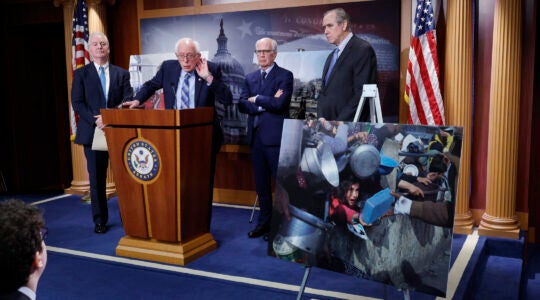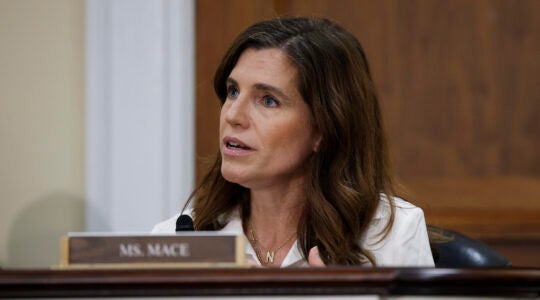NEW YORK (JTA) – Harriet Mouchly-Weiss has a 2-foot tall stack of abject letters from nonprofit organizations telling her of their dire financial straits because of the economic meltdown.
It was probably an ineffective approach – at least for Mouchly-Weiss.
“If I get one more pathetic letter I am going to croak,” the New Yorker told JTA.
In the nonprofit world, marketing is often a nice word for fund raising, and if organizations are going to listen to anyone about how to message their causes now, it should be Mouchly-Weiss. She is the managing partner at Strategy XXI, a marketing consulting firm that specializes in nonprofits.
Mouchly-Weiss also sits on the executive committee of the UJA-Federation of New York, and is on the boards of the New Israel Fund, the Abraham Fund and the Israel Policy Forum.
Her message is clear: With nonprofits facing a shrinking fund-raising pool as funders either lose money or become more tightfisted, organizations will have to come up with an effective pitch for convincing donors that they are running tight ships. And nonprofits have to recognize that their messaging may be their meal tickets.
Or as Gary Wexler, the president of Passion Marketing, a creative marketing firm that focuses on the nonprofit sector, puts it, “Marketing is going to be everything in this time.”
Wexler, a JTA board member, adds: “If nonprofits don’t tie their fund raising to marketing and integrating it, they will be sunk.”
The first step, Mouchly-Weiss says, is for nonprofits to become less frivolous. They must let their donors know that they are cutting ancillary expenses, such as expensive dinners, and focusing solely on fulfilling their missions.
“I hope the situation will compel us to go right to the issue, as opposed to focusing on entertaining people,” she said. “People are going to be much more critical of the way money is spent. People will look at overhead. And then I think that nonprofits are going to have to demonstrate the real need and effectiveness of their solutions.”
The Israel Policy Forum, an advocacy group that Mouchly-Weiss chairs, eliminated the glitz from its upcoming annual banquet. In June the group had booked the grand ballroom at the Hyatt Hotel in Manhattan, but recently decided to downgrade to a smaller space at the hotel.
IPF, which pushes for deeper U.S. involvement in the Israeli-Palestinian conflict, also opted to focus more on an educational program instead of a posh reception, and slashed the ticket cost from $1,000 to $500.
“We have really tried to avoid the quintessential rubber chicken New York dinner,” the organization’s executive director, Nick Bunzl, said. “And this year we have particularly tried to focus on change.”
Nonprofits should emphasize their emergency, says Gary Tobin, the president of the Institute for Jewish and Community Research in San Francisco, which studies the Jewish nonprofit sector.
“What is going to matter most to people are those programs for the hungry and the poor, people on Medicare and the homeless,” Tobin said.
“You have to appeal to a shift in priorities and mission in a time of crisis. JCCs should be emphasizing scholarships, day schools the same,” he said. “Everybody needs programs that serve people in need. It’s just a matter of how you package it.”
For the Jewish Agency for Israel, the trick will be communicating to American donors that overseas Jewish needs are just as important as domestic needs, says the director of its North American communications department, Jacob Dallal.
The Jewish Agency, a century-old organization that focuses on promoting immigration to Israel and Zionist education in Diaspora communities, has been hit with a “double whammy,” with donations in the United States falling as the cost of providing services overseas rise.
For instance, because of inflation and the falling dollar, the cost of sending a child to a session at a summer camp in the former Soviet Union has jumped from $670 to $850.
While the Jewish Agency has made its financial troubles public, donors may not respond to that message alone, Dallal said.
“It’s part of the argument, but I don’t think it is the whole argument,” he said. “We have to explain how we fit into the larger picture and we will continue to do that. It is then up to Mr. and Mrs. Cohen in Oklahoma who give money to their local federation to decide. We have to give as clear as possible all the information that we can about how our programs run.”
Donors will give to causes they deem important during tough times, said Steve Rabinowitz, a founding partner at Rabinowitz-Dorf Communications, which specializes in strategies for nonprofits and political interests. He cites the unprecedented amounts raised over the past two years for presidential campaigns.
But, Rabinowitz adds, nonprofits must strengthen their messages and prove to their benefactors that they remain vital.
“What is the value in the sky-is-falling method?” he asks, noting that several nonprofits with which he consults have alternated sending messages of desperation and strength. “Several nonprofits are now afraid of advertising large gifts they receive because it might tell smaller donors that they don’t need smaller gifts. But if they claim poverty, then it might” signal that – for a reason – no one is giving.
“It is a real Catch 22,” Rabinowitz says, “but organizations have to show that despite the difficult times, people are continuing to give because it continues to be part of their lives. They just have to take into account people’s difficulty or nervousness, and be understanding and make the case that yours continues to be a community priority.”
The UJA-Federation of New York may have caught on first.
In late September, just as the economy was falling into meltdown mode, the federation raised $43 million in one night at its largest fund-raiser, the Ace Greenberg dinner – an increase of $2 million over the previous year.
For weeks before the event, the federation’s CEO and executive vice president, John Ruskay, and other top staff met personally with major donors stressing that they had to keep up their donations and in some cases increase them. Ruskay had a simple pitch: Those who can give, should give.
The rest of the North American federation system, which takes in about $1 billion annually through the federations’ collective annual campaigns, is trying to pick up on Ruskay’s message, says Adam Smolyar, the senior vice president for strategic communications and marketing at the United Jewish Communities.
The UJC, the umbrella organization for the federation system, is forming talking points to pass on to the federations that play off the New York message, he said. And the UJC has started an Internet-based message board for marketing directors at federations to bounce ideas off each other and share best practices.
“We need to deal with how you both raise money from the existing donor base when the donors are affected by the economic situation and how you make the case for giving more persuasive and acute at this time,” Smolyar said.
“Marketing and fund raising in my opinion absolutely have to work together. In our case in particular, the messaging needs to be refined and updated. We need to talk about the reasons why people should give to the annual campaign, what it provides, and what services are provided to help people like you. These are all marketing messages.”
But Wexler of Passion Marketing says that nonprofits now must think beyond their own message and figure out how to work together as a sector.
“Everybody at all these nonprofits thinks that we have to get the message out and say how much more we need them because people are slipping into poverty and people are losing their jobs,” said Wexler, who is working on strategies with several federations, including in Los Angeles and Toronto. “But that is the typical answer. They need to think beyond this and ask, ‘What are the big ideas? Where are other organizations in our regional area looking during this time? And what kind of big thinking can we do to be able to collaborate with other nonprofits? What are our common marketing issues? ‘ “
Wexler is trying to help the Los Angeles federation convene the city’s major nonprofits – Jewish and non-Jewish – to speak about how they can work together.
The trouble, he said, is that most nonprofits are starting to strategize way too late in the game.
“The organizations needed to be thinking about this a year ago and seeing that this was happening,” Wexler said, “but most didn’t and now they are caught with their pants down.”
At the same time, he expressed alarm over the attempts by several nonprofits to make the economic crisis the center of their marketing message.
“Now there is almost a panic, and nonprofits are becoming emergency shops saying that this has become their major project and goal, and they are abandoning the process of maintaining who they are,” Wexler said. “It will be essential that they stay on mission.”
JTA has documented Jewish history in real-time for over a century. Keep our journalism strong by joining us in supporting independent, award-winning reporting.





